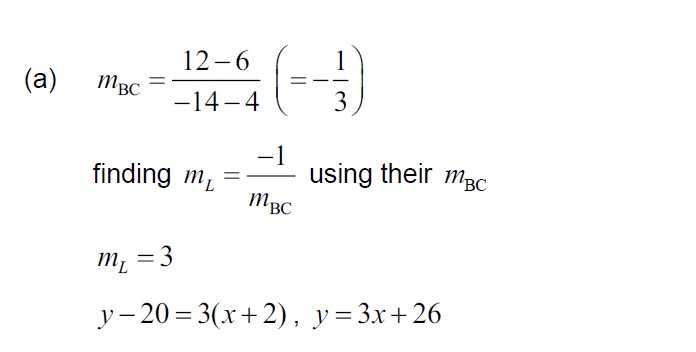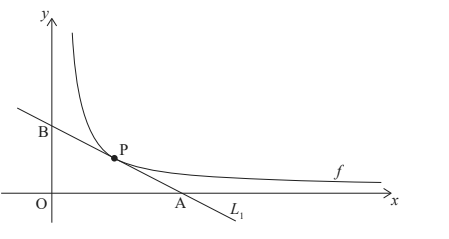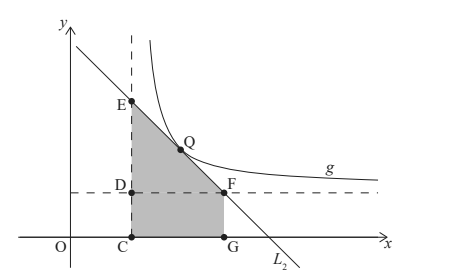Question
Point P has coordinates (-3 , 2), and point Q has coordinates (15, -8). Point M is the midpoint of [PQ].
(a) Find the coordinates of M.
Line L is perpendicular to [PQ] and passes through M.
(b) Find the gradient of L.
(c) Hence, write down the equation of L.
Answer/Explanation
Answer:
(a) M (6, -3)
(b) gradient of [PQ] = -\(\frac{5}{9}\)
gradient of L = \(\frac{5}{9}\)
(c) y + 3 = \(\frac{9}{5}\)(x – 6) OR y = \(\frac{9}{5}\) x – \(\frac{69}{5}\) (or equivalent)
Question
Consider the points A (-2 , 20) , B (4 , 6) and C (-14 , 12) . The line L passes through the point A and is perpendicular to [BC] .
(a) Find the equation of L . [3]
The line L passes through the point (k , 2) .
(b) Find the value of k .
Answer/Explanation
Ans

b.
substituting (k , 2) into their L
2 − 20 = 3(k + 2)
OR
2 = 3k + 26
k=-8
Question
The following diagram shows part of the graph of f (x) = \(\frac{k}{x}\), for x > 0, k > 0.
Let P, \(p(p,\frac{k}{p})\) be any point on the graph of f . Line L1 is the tangent to the graph of f at P.
 x
x(i) Find f ′( p) in terms of k and p .
(ii) Show that the equation of L1 is kx + p2y – 2pk = 0. [4]
Line L1 intersects the x-axis at point A(2p , 0) and the y-axis at point B.
Find the area of triangle AOB in terms of k . [5]
The graph of f is translated by \((_{3}^{4})\) to give the graph of g .
In the following diagram:
point Q lies on the graph of g
points C, D and E lie on the vertical asymptote of g
points D and F lie on the horizontal asymptote of g
point G lies on the x-axis such that FG is parallel to DC.
Line L2 is the tangent to the graph of g at Q, and passes through E and F.

Given that triangle EDF and rectangle CDFG have equal areas, find the gradient of L2 in terms of p . [6]
Answer/Explanation
Ans:
(a)
(i)
f'(x)= \(-kx^{-2}\)
\(f'(p)= -kp^{-2} (= – \frac{k}{p^{2}})\)
(ii)
attempt to use point and gradient to find equation of L1
eg y- \(\frac{k}{p}= – kp^{-2}(x-p), \frac{k}{p}= -\frac{k}{p^{2}}(p)\)+b
correct working leading to answer
eg \(p^{2}y-kp = -kx+kp, y -\frac{k}{p} =-\frac{k}{p^{2}}x+ \frac{k}{p}y=-\frac{k}{p^{2}}x+\frac{2k}{p}\)
\(kx+p^{2}\)y-2pk=0
(b)
METHOD 1
– area of a triangle
recognizing x = 0 at B
correct working to find y -coordinate of B
\(p^{2}y-2pk=0\)
y -coordinate of B at y = \(\frac{2k}{p}\)(may be seen in area formula)
correct substitution to find area of triangle
eg \(\frac{1}{2}(2p)(\frac{2k}{p}),p \times (\frac{2k}{p})\)
area of triangle AOB = 2k
METHOD 2 –
integration recognizing to integrate L1 between 0 and 2p
eg \(\int_{0}^{2p}L_{1}dx, \int_{0}^{2p} – \frac{k}{p^{2}}x+ \frac{2k}{p}\)
correct integration of both terms
eg \(-\frac{kx^{2}}{2p^{2}}+\frac{2kx}{p},-\frac{k}{2p^{2}}x^{2}+\frac{2k}{p}x+c\),
substituting limits into their integrated function and subtracting (in either order)
eg \(-\frac{k(2p^{2})}{2p^{2}}+\frac{2k(2p)}{p}-(0),-\frac{4kp^{2}}{2p^{2}}+\frac{4kp}{p}\)
correct working
eg -2k+4k
area of triangle AOB = 2K
(c)
recognizing use of transformation
eg area of triangle AOB = area of triangle DEF, g(x)= \(\frac{k}{x-4}+3\)
gradient of \(L_{2}\)= gradient of \(L_{1} ,D(4,3)\),2p+4, one correct shift
correct working
eg area of tringle DEF = 2k, CD = 3, DF= 2P, CG= 2P, E(4,\(\frac{2k}{p}+3)\)
area of rectangle CDFG = 2k
valid approach
eg \(\frac{ED\times DF}{2}\)=\(CD\times DF 2P.3= 2K ,ED =CD \), \(\int_{4}^{2P+4}L_{2}\)dx= 4k
correct working
eg ED = 6, E(4,9),K= 3p, gradient = \(\frac{3-(\frac{2k}{p}+3)}{(2p+4)-4},\frac{-6}{\frac{2k}{3}},-\frac{9}{k}\)
eg \(\frac{-6}{2p},\frac{9-3}{4-(2p+4)},-\frac{3p}{p^2},\frac{3-(\frac{2(3p)}{p}+3)}{(2p+4)-4}, – \frac{9}{3p}\)
gradient of
\(L_{2}is – \frac{3}{p}(=-3p^{-1})\)
Question
P (4, 1) and Q (0, –5) are points on the coordinate plane.
Determine the
(i) coordinates of M, the midpoint of P and Q.
(ii) gradient of the line drawn through P and Q.
(iii) gradient of the line drawn through M, perpendicular to PQ.[4]
The perpendicular line drawn through M meets the y-axis at R (0, k).
Find k.[2]
Answer/Explanation
Markscheme
(i) (2, – 2) parentheses not required. (A1)
(ii) gradient of PQ \( = \left( {\frac{{ – 5 – 1}}{{0 – 4}}} \right) = \frac{6}{4} = \frac{3}{2}(1.5)\) (M1)(A1)
(M1) for gradient formula with correct substitution
Award (A1) for \(y = \frac{3}{2}x – 5\) with no other working
(iii) gradient of perpendicular is \( – \frac{2}{3}\) (A1)(ft) (C4)[4 marks]
\(\left( {\frac{{k + 2}}{{0 – 2}}} \right) = – \frac{2}{3}\), \(k = – \frac{2}{3}\) or \(y = – \frac{2}{3}x + c\), \(c = – \frac{2}{3}\therefore k = – \frac{2}{3}\) (M1)(A1)(ft)
Allow (\(0, – \frac{2}{3}\))
(M1) is for equating gradients or substituting gradient into \(y = mx + c\) (C2)[2 marks]
Question
Write down the gradient of the line \(y = 3x + 4\).[1]
Find the gradient of the line which is perpendicular to the line \(y = 3x + 4\).[1]
Find the equation of the line which is perpendicular to \(y = 3x + 4\) and which passes through the point \((6{\text{, }}7)\).[2]
Find the coordinates of the point of intersection of these two lines.[2]
Answer/Explanation
Markscheme
\(3\) (A1) (C1)[1 mark]
\( – 1/3\) (ft) from (a) (A1)(ft) (C1)[1 mark]
Substituting \((6{\text{, }}7)\) in \(y ={\text{their }}mx + c\) or equivalent to find \(c\). (M1)
\(y = \frac{{ – 1}}{3}x + 9\) or equivalent (A1)(ft) (C2)[2 marks]
\((1.5{\text{, }}8.5)\) (A1)(A1)(ft) (C2)
Note: Award (A1) for \(1.5\), (A1) for \(8.5\). (ft) from (c), brackets not required.[2 marks]
Question
A straight line, \({L_1}\) , has equation \(x + 4y + 34 = 0\) .
Find the gradient of \({L_1}\) .[2]
The equation of line \({L_2}\) is \(y = mx\) . \({L_2}\) is perpendicular to \({L_1}\) .
Find the value of \(m\).[2]
The equation of line \({L_2}\) is \(y = mx\) . \({L_2}\) is perpendicular to \({L_1}\) .
Find the coordinates of the point of intersection of the lines \({L_1}\) and \({L_2}\) .[2]
Answer/Explanation
Markscheme
\(4y = – x – 34\) or similar rearrangement (M1)
\({\text{Gradient}} = – \frac{1}{4}\) (A1) (C2)
\(m = 4\) (A1)(ft)(A1)(ft) (C2)
Note: (A1) Change of sign
(A1) Use of reciprocal[2 marks]
Reasonable attempt to solve equations simultaneously (M1)
\(( – 2{\text{, }} – 8)\) (A1)(ft) (C2)
Note: Accept \(x = – 2\) \(y = – 8\). Award (A0) if brackets not included.[2 marks]
Question
[Maximum mark: 6] [with / without GDC]
Consider the line \(L\) with equation \(y + 2x = 3\). The line \(L\)1 is parallel to L and passes
through the point (6, –4).
(a) Find the gradient of \(L\)1.
(b) Find the equation of \(L\)1 in the form \(y = mx + b\).
(c) Find the x-coordinate of the point where line \(L\)1 crosses the x-axis.
Answer/Explanation
Ans.
(a) y = -2x + 3
gradient of line \(L\)1 =-2
(b) METHOD 1
\((y-(-4))=-2(x-6)\)
\(y+4=-2x+12\)
\(y=-2x+8\)
METHOD 2
Substituting the point (6,-4) in \(y = mx + c\) ,
-4 = –2(6) + c ⇔ c = 8
y =-2x + 8
(c) when line \(L\)1 cuts the x-axis, \(y = 0\)
y =-2x + 8
x = 4